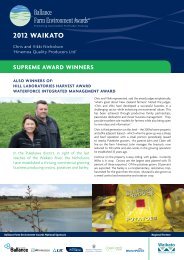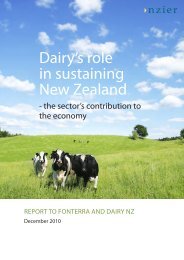You also want an ePaper? Increase the reach of your titles
YUMPU automatically turns print PDFs into web optimized ePapers that Google loves.
NELSON<br />
AND TASMAN<br />
STRONG AND<br />
HEALTHY BEES ARE<br />
A CRITICAL PART<br />
OF PROFITABLE<br />
AGRICULTURE<br />
<strong>Federated</strong> <strong>Farmers</strong> of New Zeal<strong>and</strong><br />
T: 04 473 7269 or 0800 327 646<br />
F: 04 473 1081<br />
E: mail@fedfarm.org.nz<br />
www.fedfarm.org.nz<br />
Smart Farming For Healthy Bees<br />
BEE FRIENDLY LAND MANAGEMENT<br />
REGION - NELSON AND TASMAN<br />
To ensure the future of farming, all farmers need<br />
to play their part in protecting the honey bee. The<br />
bee is one of the hardest workers in horticulture<br />
<strong>and</strong> agriculture; about $3 billion of our GDP is<br />
directly attributable to the intensive pollination<br />
of horticultural <strong>and</strong> specialty agricultural crops<br />
by bees. In addition there is a huge indirect<br />
contribution through the pollination of clover,<br />
sown as a nitrogen regeneration source for the<br />
l<strong>and</strong> we farm. This benefi t fl ows on to our meat<br />
export industry through livestock production<br />
<strong>and</strong> sales.<br />
The beekeeping industry is facing some of its<br />
biggest challenges with increasing bee pests<br />
<strong>and</strong> diseases. This is of great concern because,<br />
in terms of the food we eat, about a third of<br />
the calories <strong>and</strong> three-quarters of the diversity<br />
rely on bees for pollination.<br />
The most important issue leading to a bee<br />
crisis in NZ is declining fl oral resources <strong>and</strong> the<br />
subsequent scarcity of quality pollen, which<br />
leads to bee malnutrition. The key to good bee<br />
health is a continual supply of diverse pollen<br />
<strong>and</strong> nectar from natural sources.<br />
www.fedfarm.org.nz/ourcampaigns<br />
October 2009<br />
Honey bee on Ngaio (Myoporum laetum)<br />
Bees consume pollen as a protein <strong>and</strong> vitamin<br />
source <strong>and</strong> nectar for energy. While gathering<br />
these resources, they move pollen from one<br />
plant to another thus benefi ting the farm by<br />
pollinating crops. Availability of quality pollen<br />
resources is critical during spring when beekeepers<br />
are building up bee populations for pollination<br />
services. Any shortfall leads to protein stress that<br />
weakens bees making them more susceptible<br />
to diseases <strong>and</strong> pests (e.g., varroa mite); it<br />
also dramatically slows the queens breeding<br />
output <strong>and</strong> this results in low fi eld strength <strong>and</strong><br />
under-performing pollination services.<br />
Today, farmers can reverse this trend by choosing<br />
bee friendly trees <strong>and</strong> shrubs for planting in<br />
waterway margins, windbreaks, fi eld edges,<br />
under pivots <strong>and</strong> along roadsides. Fortunately<br />
a number of shelter <strong>and</strong> erosion control plants<br />
have abundant fl owers to feed bees so selecting<br />
multi-purpose plants is smart farming for healthy<br />
bees.<br />
This fact sheet will help you provide pollen that<br />
these vital creatures need. To fi nd out where to<br />
source the plants on this list please go to www.<br />
plantfi nder.co.nz or ask at your local nursery.<br />
Photo: Lara Nicholson © L<strong>and</strong>care Research
LEGEND: Common Name (Scientific name) --- Life form, Maximum height in metres, Months of flowering<br />
Native Trees <strong>and</strong> Shrubs for Bees<br />
Native plants are the best choice to increase “on-farm” native biodiversity <strong>and</strong> benefit both the honey bee <strong>and</strong> the environment.<br />
Cabbage tree (Cordyline australis) --- Tree, 15m, Oct-Dec<br />
Five-finger (Pseudopanax arboreus) --- Tree, 8m, Jun-Aug<br />
Horoeka (Pseudopanax crassifolius) --- Tree, 6m<br />
Kāmahi (Weinmannia racemosa) --- Tree, 20m, Dec-Jan<br />
Kānuka (Kunzea ericoides) --- Tree/Shrub, 15m, Sep-Feb<br />
Kohuhu (Pittosporum tenuifolium) --- Tree, 6m, Oct-Nov<br />
Koromiko (Hebe salicifolia) --- Shrub, 3m, Jan-Feb-(Apr)<br />
Lemonwood (Pittosporum eugenioides) --- Tree, 10m, Oct-Dec<br />
Manuka (Leptospermum scoparium) --- Tree/Shrub, 5m, Sep-Mar<br />
Matagouri (Discaria toumatou) --- Tree/Shrub, 5m, Oct-Jan<br />
Narrow-lv lacebark (Hoheria angustifolia) -- Tree, 10m, Dec-Mar<br />
Ngaio (Myoporum laetum) --- Tree/Shrub, 10m, Jul-Apr<br />
Non-native Trees <strong>and</strong> Shrubs for Bees<br />
NZ flax (Phormium tenax) --- Tufted, up to 5m flw. stalk, Nov-Dec<br />
Ramarama (Lophomyrtus bullata) --- Tree/Shrub, 5m, Nov-Feb<br />
Rata (Metrosideros robusta) --- Tree, 25m, Nov-Jan<br />
Ribbonwood (Plagianthus regius) --- Tree, 6m, Sep-Nov<br />
Scented broom (Carmichaelia odorata) --- Shrub, 3m<br />
South Isl<strong>and</strong> kowhai (Sophora prostrata) --- Shrub, 2m<br />
Sth. Rata (Metrosideros umbellata) -- Tree/Shrub, 15m, Nov-Jan-(Mar)<br />
Weeping kowhai (Sophora microphylla) --- Tree, 10m<br />
Weeping matipo (Myrsine divaricata) --- Shrub, 3m, Jun-Nov<br />
Westl<strong>and</strong> quintinia (Quintinia acutifolia) --- Tree, 12m, Oct-Nov<br />
Wharangi (Melicope ternata) --- Shrub, 8m, Sep-Oct<br />
Whiteywood (Melicytus ramiflorus) --- Tree, 10m, Nov-Feb<br />
Exotic plants are good choices because many are multi-purpose for farming <strong>and</strong> have excellent pollen <strong>and</strong> nectar.<br />
Apple (Malus ×domestica) --- Tree, Sep-Nov<br />
Bottlebrush (Callistemon spp.) --- Shrub, 2m<br />
Grevillea (Grevillea spp.) --- Tree/Shrub, Sep-Nov<br />
Lavender (Lav<strong>and</strong>ula spp.) Shrub, 1m, Sep-Dec<br />
Pear (Pyrus communis) --- Tree, Sep-Oct<br />
Red flowering gum (Corymbia ficifolia) --- Tree, 10m, Dec-Feb<br />
Rosemary (Rosmarinus officinalis) --- Shrub, 1.5m, Sep-Nov<br />
Tree lucerne (Chamaecytisus palmensis) --- Tree, 5m, May-Oct<br />
Weeping willow (Salix babylonica) --- Tree, 25m, Aug-Sep<br />
White ironbark (Eucalyptus leucoxylon) --- Tree, 30m, Mar-Nov<br />
To match plants to your site, consult a plant adviser, e.g. Vibrant Earth Nursery Phone: 03 544 8087 Email:plants@vibrantearth.co.nz<br />
The plants listed above are examples of good Bee Plants that are not on any list of pest plants (weeds) for <strong>Tasman</strong>-<strong>Nelson</strong>. See our website<br />
for further examples <strong>and</strong> guidelines. Although some plants are good for bees they are on pest plant lists because they are invasive. Planting<br />
them would be detrimental to farmers or to the environment <strong>and</strong> in some cases even illegal (e.g., Unwanted Organisms list). Lists of pest<br />
plants change regularly so it is best to consult your regional authorities.<br />
<strong>Tasman</strong>-<strong>Nelson</strong> Regional Pest Management Strategy is listed<br />
1 at http://www.biosecurityperformance.maf.govt.nz/ 2<br />
Plants listed in the strategy must not be planted for various<br />
reasons. For advice in your area, contact <strong>Nelson</strong> City Council<br />
(Phone 03 546 0200; www.ncc.govt.nz ) or <strong>Tasman</strong> District<br />
Council: Phone 03 543 8400; www.tasman.govt.nz).<br />
3<br />
For example do not plant:<br />
Gorse (Ulex europaeus) --- Shrub<br />
Blackberry (Rubus fruticosus) --- Shrub<br />
Scotch broom (Cytisus scoparius) --- Shrub<br />
The National Pest Plant Accord (NPPA) is listed at<br />
www.biosecurity.govt.nz/nppa.<br />
Plants listed on the NPPA are unwanted organisms under the<br />
Biosecurity Act 1993 <strong>and</strong> cannot be sold, propagated or<br />
distributed even though some are high value bee plants<br />
For example do not plant:<br />
Crack willow (Salix fragilis) --- Tree<br />
Grey willow (Salix cinerea) --- Tree/Shrub<br />
Lantana (Lantana camara) --- Shrub<br />
Scottish heather (Calluna vulgaris) --- Shrub<br />
The Department of Conservation (DOC) Weed List contains around 20 high value bee plants that are aggressive environmental weeds. To<br />
protect the environment, please consult a DOC weed expert for your situation<br />
www.doc.govt.nz/conservation/threats-<strong>and</strong>-mpacts/weeds/docs-weed-work/<br />
Thanks to the New Zeal<strong>and</strong> Charitable Honey Industry Trust for funding. This list was produced from L<strong>and</strong>care Research databases<br />
http://nzflora.l<strong>and</strong>careresearch.co.nz/ with support from the Oceania Pollinator Initiative www.oceaniapollinator.org. For other regional<br />
Bee Plant Guides <strong>and</strong> how to use them see <strong>Federated</strong> <strong>Farmers</strong> website www.fedfarm.org.nz/ourcampaigns or contact Shona<br />
Sluys at ssluys@fedfarm.org.nz or Linda Newstrom-Lloyd at newstroml@l<strong>and</strong>careresearch.co.nz
















